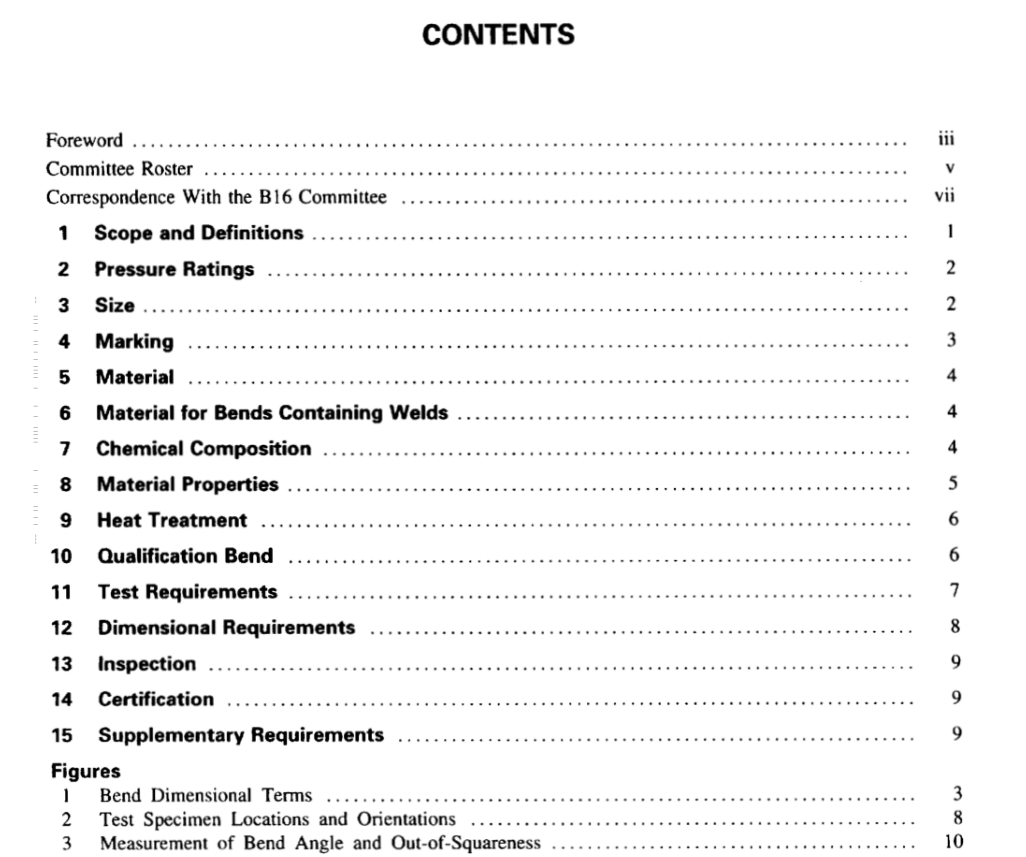ASME B16.49:2000 pdf free download FACTORY-MADE WROUCHT STEEL BUTTWELDING INDUCTI”‘ BENDS FOR TRANSPORTATION AND DISTRIBUTION SYSTEMS
1 SCOPE AND DEFINITIONS
1.1 General This Standard covers design, material, manufacturing, testing, marking, and inspection requirements for fac- tory-made pipeline bends of carbon steel materials having controlled chemistry and mechanical properties, produced by the induction bending process, with or without tangents. This Standard covers induction bends for transportation and distribution piping applications (e.g., ASME B31.4, 831.8, and B31.1 I). Process and power piping have differing requirements and materials that may not be appropriate for the restrictions and examinations described herein, and therefore are not included in this Standard.
1.2 Manufacturing Process This process utilizes induction heating to heat a narrow band 360 deg around pipe at the point of bending as the pipe is being pushed through the inductor coil at a constant velocity. After the material passes through the coil it may be cooled by forced air or water spray, or it may be allowed to cool in still air. Bends in any producible wall thickness and diameter are covered. Induction bends ‘covered by this Standard may be produced from seamless pipe, welded pipe, or cylinders.
1.3 Fabricated Bends Larger angle bends obtained by girth welding two or more smaller angle bends together are considered pipe fabrications and as such are not within the scope of this Standard.
1.4 Standard Units The values stated in either metric units or U.S. customary units are to be regarded separately as stan- dard. Within the text, customary values are shown in parentheses. The values stated in each system are not exact equivalents; therefore, each system must be used independently of the other. Combining values from two systems may result in nonconformance with the Standard.
1.5 References Standards and specifications adopted by reference in this Standard are shown in mandatory Annex I. It is not practical to identify the specific edition of each Standard and specification in the individual references. Instead, the specific edition reference is identified in Annex I. A product made in conformance with a prior edition of reference Standards and in all other respects conforming to this Standard will be considered to be in compliance.
1.6 Codes and Regulations A bend used under the jurisdiction of a referencing code or a governmental regulation is subject to any limitation of that code or regulation. This includes any maximum temperature limitation or rule governing the use of a material at low temperature.
1.7 Service Conditions Criteria for selection of bend material for a particular fluid service are not within the scope of this Standard.
1.8 Convention In conformance with this Standard, the convention for fixing significant digits where limits, maximum and minimum values, are specified shall be “rounded off’ as defined in ASTM Practice E 29. This requires that an observed or calculated value shall be rounded off to the nearest unit in the last right-hand digit used for expressing the limit. Decimal values and tolerance do not imply a particular method of measurement.
1.9 Quality Systems Requirements relating to the manufacturers’ quality system programs are described in nonmandatory Annex A.
1.10 Glossary
bend qualification procedure: document that specifiesthe properties of the starting pipe,the equipment tobe used,the bending parameters,the qualification bendtest results,the post-bend heat-treat equipment andcycle,the nondestructive testing procedures,and theweld end bevel details used for the manufacture of thebends.
cylinder: a pipe produced by the bender by rolling andwelding the plate in the facility (or by subcontracting) asopposed to pipe produced in accordance with a recog-nized specification.
extrados: the outside arc of the bend.intrados: the inside arc of the bend.
minimum (design) wall thickness:the wall thicknessspecified on the fabrication drawing or computed inaccordance with the piping code as the minimum accept-able for the temperature and pressure application.
ASME B16.49:2000 pdf free download
